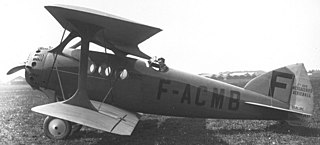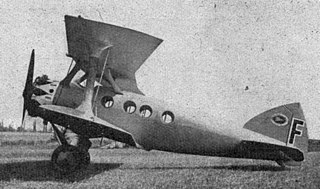Related Research Articles

The Hawker 800 is a mid-size twinjet corporate aircraft. It is a development of the British Aerospace BAe 125, and was assembled by Hawker Beechcraft.

The Blériot-SPAD S.34 was a French twin-seat, single-engine biplane flight training aircraft designed in 1920. The side-by-side seating arrangement was unique for its time. 150 aircraft were built, 125 for the French Air Force, who used them until 1936.

The Kokusai Ku-7 Manazuru was a large experimental twin boom Japanese military glider.

The Blériot Bl-115 was a French biplane airliner of the 1920s, best remembered for the part it played in the French exploration of Africa. For its day, it was a large aircraft, mounting one pair of engines on the upper wing and one pair on the lower. First flying on 9 May 1923, the prototype crashed on 23 June, killing its pilot, Jean Casale.

The Blériot 125 was a highly unusual French airliner of the early 1930s. Displayed at the 1930 Salon de l'Aéronautique in Paris, it featured accommodation for twelve passengers in separate twin fuselages. Between them, these pods shared a tailplane and a high wing. The centre section of wing joined the fuselage pods and also carried a nacelle that contained an engine at either end and the crew compartment in the middle. When flown the following year, it displayed very poor flight characteristics and although attempts to improve it continued on into 1933, certification could not be achieved and the sole prototype was scrapped the following year.

The Blériot 127 was a French bomber aircraft of the 1920s and 1930s, developed from the Blériot 117 escort fighter. It was a large monoplane of conventional configuration that featured open gunner's positions in its nose and at the rear of its two underwing engine nacelles. The wing airfoil was of sufficient thickness that these latter positions could be accessed from the fuselage in flight.
The Blériot 135 was a French airliner of the 1920s, a development of the Blériot 115 with more powerful, radial engines. One of the two built was a converted 115, the other new. Both served with Air Union on their Paris–London route from mid-1924.

The Blériot 155 was a French airliner of the 1920s. It was a four-engined biplane developed from the Blériot 115 and 135, but larger than these aircraft. Two were built for use by Air Union on their Paris-London route. Both were lost in accidents in 1926.

The Blériot 165 was a French airliner of the 1920s. It was a four-engined biplane, a final development in the family of designs that began with the Blériot 115. Two were built for Air Union to replace the Farman Goliath on their Paris–London route and were christened Leonardo da Vinci and Octave Chanute. The airline found that it preferred the Lioré et Olivier LeO 21s that it had ordered alongside this aircraft, meaning that no further examples were produced.

The Blériot 5190 was a French transatlantic mail plane of the 1930s, a large parasol-wing monoplane flying boat. It was of slightly unusual design, with a low-profile hull and the crew compartment housed in the thick pylon that supported the wing. The four engines were arranged with three along the leading edge of the wing, and the fourth on the centreline of the trailing edge. It was constructed for a French government contract to carry airmail to South America.

The Blériot-SPAD S.27 was a small French airliner developed soon after World War I. It was produced as a way for the Blériot company to find new markets for its wartime products in the postwar market, in this instance by adapting the design of the S.20 fighter into a small airliner. Accommodation for two passengers was provided in a small cabin within the fuselage, but in other respects the S.27 strongly resembled its predecessor.

The Bleriot-SPAD S.33 was a small French airliner developed soon after World War I. The aircraft was a biplane of conventional configuration whose design owed much to the Blériot company's contemporary fighter designs such as the S.20. Four passengers could be accommodated in an enclosed cabin within the monocoque fuselage, and a fifth passenger could ride in the open cockpit beside the pilot. A great success, the S.33 dominated its field throughout the 1920s, initially on CMA's Paris-London route, and later on continental routes serviced by Franco-Roumaine.

The Blériot-SPAD S.46 was a small French airliner of the 1920s, developed from the Blériot-SPAD S.33. Like its predecessor, it was a conventional biplane that seated four passengers in an enclosed cabin while the pilot and occasionally a fifth passenger rode in an open cockpit. The S.46 had a redesigned wing of longer span and a far more powerful engine. The type was employed by Franco-Roumaine, which purchased 38 out of the 40 examples produced for use on their continental European routes.

The Blériot-SPAD S.56 was a family of French airliners developed in the 1920s as various refinements of the S.33 design. All S.56 versions shared two new features: the first was a newly designed, all-metal wing, replacing the wooden wing of earlier related designs and the second was a redesigned passenger cabin, replacing the S.33's four single seats in a row with two rows of double seats. A second access door was also added.

The Blériot 111 was a French four-seat executive transport monoplane designed by André Herbemont. The first French aircraft to be fitted with a retractable landing gear, after six years development it was not ordered into production.
The Blériot 195 was a French monoplane mail-carrier designed and built by Blériot Aéronautique, the one aircraft built was modified a number of times but failed to enter production.

The Blériot XIII was an experimental passenger-carrying aircraft built during 1910 by Recherches Aéronautique Louis Blériot. It is notable for setting a record for passenger carrying flights, and was probably intended as a developmental aircraft for the Blériot XXIV Limousine.
The Blériot-SPAD S.29 was a sport aircraft produced in 1919 by Blériot-SPAD.
The St Croix Pietenopol Aircamper is an American homebuilt aircraft, an adaptation of the classic 1920s Pietenpol Air Camper, re-designed by St Croix Aircraft of Corning, Iowa. When it was available the aircraft was supplied as a partial kit and in the form of plans for amateur construction.

The Blériot-Spad S.45 was a large, four engine French airliner which appeared at the 1921 Paris Salon. It could carry fifteen passengers or be adapted as a bomber.
References
- ↑ "Blériot Bl-105 - avion de transport civil - Un siècle d'aviation française". aviafrance.com. Retrieved 2019-02-03.